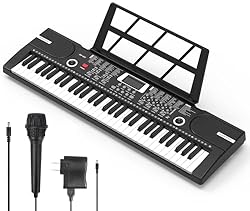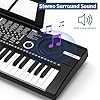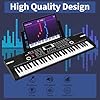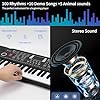Table of Contents
Explore the Best Digital Pianos with Bluetooth Connectivity
Discover the convenience and versatility of digital pianos with Bluetooth connectivity. Whether you are a budding musician or an experienced pianist, these pianos offer a seamless integration with various devices for an enhanced musical experience. Equipped with the latest technology, these pianos allow you to connect with music apps, use headphones, and even record performances digitally. Delve into the features, benefits, and models that stand out in the current market.
Roland FP-90X
The Roland FP-90X represents the pinnacle of Roland’s FP series. Known for its high-resolution sound engine and exceptional key action, this model also excels in connectivity. The piano’s Bluetooth audio and MIDI capabilities allow users to connect seamlessly with educational apps or to stream music directly to the piano’s high-quality onboard speakers, enhancing the playing experience or simplifying practice sessions.
Yamaha Arius Series 88-Key Weighted Action Digital Piano for Aspiring Musicians, CFX Concert Grand Piano Voice, 3-Pedal Unit, Bench Included, Classic Upright Design, Dark Rosewood YDP145R
17% OffYamaha Arius Series 88-Key Weighted Action Upright Digital Piano, CFX Concert Grand Piano Voice, 3-Pedal Unit, Bench Included, Classic Upright Design, Black YDP145B
17% OffDonner Digital Piano Keyboard Velocity-Sensitive 88 Keys with Removable Piano Stand, Compact Beginner Home Electric Piano with Split Mode, LED Digital Tube for Display, and Triple Pedal DEP-08
$279.99 (as of November 22, 2025 08:02 GMT -08:00 - More infoProduct prices and availability are accurate as of the date/time indicated and are subject to change. Any price and availability information displayed on [relevant Amazon Site(s), as applicable] at the time of purchase will apply to the purchase of this product.)Donner DEP-1S Piano Keyboard 88 Keys, Beginner Digital Piano with 88 Key Velocity-Sensitive Keyboard, Record, Bluetooth, Chord, Bundle With Piano Stand, Piano Stickers, Sustain Pedal, Retro Wood Color
$219.99 (as of November 22, 2025 08:02 GMT -08:00 - More infoProduct prices and availability are accurate as of the date/time indicated and are subject to change. Any price and availability information displayed on [relevant Amazon Site(s), as applicable] at the time of purchase will apply to the purchase of this product.)Yamaha Clavinova CLP-775
A flagship model in Yamaha’s Clavinova series, the CLP-775 features both Bluetooth MIDI and audio integration. This facilitates a wire-free connection between the piano and smart devices, enabling the use of various music-related apps. Its sophisticated GrandTouch keyboard, combined with meticulously sampled sounds from Yamaha’s concert grand pianos, offers a deeply immersive playing experience. The Bluetooth feature not only aids in educational purposes but also transforms practice into an interactive and enjoyable activity.
Kawai CA99
The Kawai CA99 digital piano stands out for its integrated Bluetooth MIDI and audio technology. This piano uses Kawai’s advanced SK-EX Rendering sound engine, which combines with its wooden key action to mimic the feel and sound of a grand piano. Bluetooth connectivity further enhances its functionality by linking with music software and apps for both educational and entertainment purposes. With its powerful speaker system, the CA99 offers a rich audio experience, transforming any room into a concert hall.
Casio Privia PX-S3000
As part of Casio’s revolutionary Privia line, the PX-S3000 is ultra-portable and loaded with features, including seamless Bluetooth connectivity. It allows for audio streaming from devices, and its Bluetooth MIDI function is perfect for using with music education apps or for recording sessions. Its sleek design, combined with a range of built-in tones and rhythms, positions it as a versatile choice for musicians at any level.
Nord Stage 3
The Nord Stage 3 offers excellent Bluetooth MIDI capabilities that make it a top choice for professional musicians. Known mainly for its stage performance, this instrument integrates seamlessly with external devices, providing a link to a wide array of MIDI-based equipment and additional sound libraries. Its comprehensive set of features and robust on-board sound system make it a dynamic and flexible instrument for live and studio settings.
Yamaha Arius Series 88-Key Weighted Action Upright Digital Piano, CFX Concert Grand Piano Voice, 3-Pedal Unit, Bench Included, Classic Upright Design, Black YDP145B
17% OffFree Piano - Learn to Play Piano
$0.00 (as of November 22, 2025 22:56 GMT -08:00 - More infoProduct prices and availability are accurate as of the date/time indicated and are subject to change. Any price and availability information displayed on [relevant Amazon Site(s), as applicable] at the time of purchase will apply to the purchase of this product.)Classical Piano for Sleep and Relaxation
$9.99 (as of November 22, 2025 22:56 GMT -08:00 - More infoProduct prices and availability are accurate as of the date/time indicated and are subject to change. Any price and availability information displayed on [relevant Amazon Site(s), as applicable] at the time of purchase will apply to the purchase of this product.)61 keys keyboard piano, Electronic Digital Piano with Built-In Speaker Microphone, Sheet Stand and Power Supply, Portable piano Keyboard Gift Teaching for Beginners
$164.00 (as of November 22, 2025 23:10 GMT -08:00 - More infoProduct prices and availability are accurate as of the date/time indicated and are subject to change. Any price and availability information displayed on [relevant Amazon Site(s), as applicable] at the time of purchase will apply to the purchase of this product.)Using Bluetooth for Wireless MIDI and Audio
When it comes to modern digital pianos, Bluetooth connectivity has become a staple feature that enhances both playing and learning experiences. Below, we explore how Bluetooth can be utilized for wireless MIDI and audio functionalities.
Bluetooth MIDI technology allows you to connect your digital piano to various devices such as tablets, smartphones, and computers without the need for physical cables. Here are some benefits of using Bluetooth for MIDI:
Audio streaming over Bluetooth is another highly convenient feature, enabling digital pianos to act as both instruments and speakers. Here’s how it helps:
In conclusion, utilizing Bluetooth for wireless MIDI and audio not only eliminates the need for cumbersome cables but also opens up a wide array of creative and functional possibilities. Whether you’re a beginner looking to learn through interactive methods or a seasoned player aiming to enhance your performance setup, Bluetooth connectivity offers immense value.
Yamaha P-125
The Yamaha P-125 is a highly popular digital piano known for its excellent sound quality and sleek design. It integrates with Yamaha’s Smart Pianist app, which provides additional learning features such as chord analysis, instrument voice control, and more. The P-125 also supports Bluetooth audio and MIDI connectivity, allowing users to easily connect to various apps for learning and practice.
Casio PX-S3100
The Casio PX-S3100 offers an impressive combination of portability and advanced features. This slim, lightweight piano includes Bluetooth connectivity for both audio and MIDI functions, making it easy to connect to learning apps. The PX-S3100 is compatible with Casio’s Chordana Play for Piano app, which offers a range of learning tools such as interactive lessons and performance tracking.
Roland FP-30X
The Roland FP-30X is a versatile digital piano with exceptional sound and playability. Its Bluetooth capabilities allow for seamless integration with Roland’s Piano Every Day app, which provides a suite of learning resources including sheet music access, daily practice logging, and rhythm accompaniments. Additionally, the FP-30X supports MIDI over Bluetooth, enabling interaction with various other educational apps.
Kawai ES110
The Kawai ES110 is renowned for its responsive touch and superior sound quality. This digital piano includes Bluetooth MIDI functionality, making it compatible with a variety of educational platforms and apps. It works well with the Kawai Virtual Technician app, which lets users customize their piano’s sound and touch settings, aiding in a personalized learning experience.
Yamaha YDP-144 Arius
The Yamaha YDP-144 Arius is ideal for both beginners and experienced players looking for a traditional upright piano experience with modern functionality. It features Bluetooth MIDI connectivity, which pairs effortlessly with Yamaha’s various educational apps such as the Smart Pianist app. Users can benefit from features like chord tracking, lesson modes, and more.
Roland GO:PIANO 88
The Roland GO:PIANO 88 offers a full 88-key keyboard in a lightweight and portable design. This model features Bluetooth connectivity, allowing it to easily sync with Roland’s Piano Partner 2 app, which offers interactive learning experiences, practice logs, and various fun and educational activities. The Bluetooth functionality also supports MIDI, making it compatible with other music learning applications.
Advantages of Bluetooth Over Traditional Connectivity
Bluetooth connectivity eliminates the need for cumbersome cables, allowing for a cleaner and more organized setup. This is particularly advantageous in home studios or live performances where mobility and space management are critical.
Connecting devices via Bluetooth is typically straightforward, involving a simple pairing process. This ease of use makes it accessible for musicians of all technical levels, enhancing user experience.
Most modern digital devices—from tablets to smartphones—come equipped with Bluetooth capabilities. This cross-device compatibility enables seamless integration with a variety of external tools and applications, such as music composition software, learning apps, and virtual instruments.
Recent advancements in Bluetooth technology have significantly reduced latency issues, making real-time audio playback and recording more reliable. This is crucial for musicians who require immediate feedback and precision.
Bluetooth provides the freedom to move around without being tethered to your instrument. This increased mobility can enhance performance dynamics and allow for more expressive playing styles.
Bluetooth offers an extended range of connectivity, allowing musicians to control their digital pianos from a distance. This is beneficial for remote teaching sessions, collaborative projects, and large spaces.
Modern Bluetooth standards are designed to consume minimal power, which helps in extending the battery life of wireless devices. This energy efficiency ensures longer usage times and reduces the need for frequent recharges.
Some digital pianos with Bluetooth capabilities offer firmware updates over the air, ensuring that your instrument always has the latest features and improvements without the need for manual downloading and installation.
Ensure Device Compatibility
Before attempting to use Bluetooth features, verify that your digital piano and external devices (like tablets, smartphones, or computers) are compatible. Check the manufacturer’s specifications and ensure both devices support the same Bluetooth version. Compatibility ensures seamless connectivity and optimal performance.
Update Firmware Regularly
Manufacturers often release firmware updates to enhance Bluetooth functionality and address any bugs or connectivity issues. Regularly check for and install firmware updates for your digital piano. This will not only improve Bluetooth stability but also incorporate new features and improvements.
Maintain a Clutter-Free Bluetooth Environment
Bluetooth signals can be disrupted by physical obstacles and other electronic devices. Keep the area around your digital piano free from excessive clutter and avoid placing devices like Wi-Fi routers or other Bluetooth gadgets nearby. This minimizes interference and ensures a stable, clear connection.
Pair Devices Properly
Always follow the manufacturer’s guidelines for pairing your digital piano with other devices. Ensure that both devices are in pairing mode and within pairing range, typically a few meters apart. A successful pairing process involves confirming any on-screen prompts to establish a secure connection.
Optimize Audio Settings
After establishing a Bluetooth connection, adjust your audio settings for optimal sound quality. Tweak the volume levels and explore equalizer settings, if available, to enhance your listening experience. Different environments may require different settings for the best audio output.
Secure Your Connection
Bluetooth connections can sometimes be accessed by unauthorized devices. For added security, use features like passkeys or authentication codes when pairing devices. Additionally, once a device is paired, set it as a trusted device to avoid repetitive manual pairing.
Manage Battery Usage
Using Bluetooth can drain the battery of both your digital piano and the connected devices. Monitor battery levels and consider having a power source nearby for longer sessions. Some digital pianos offer power-saving modes that can help extend battery life during Bluetooth use.
Troubleshoot Common Issues
If you encounter connectivity issues, try common troubleshooting steps like restarting both devices, toggling the Bluetooth function off and on, or deleting and re-pairing the devices. Consult the user manual or manufacturer’s support page for device-specific troubleshooting tips.















































